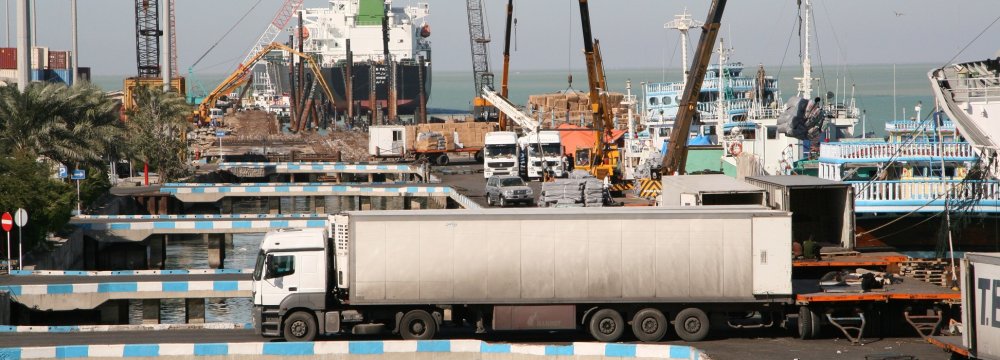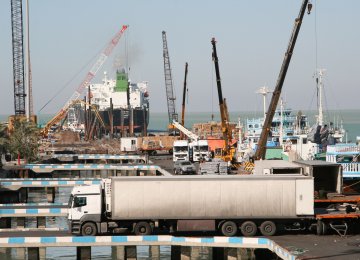Iran has a broad variety of business and logistics attractions to offer. In the last few years, the Iranian government has actively sought to develop the logistics infrastructures and improve its global ranking.
Iran used to be one of the most important countries situated on the ancient Silk Road and is considered one of the important hubs because of its strategic location in the Middle East.
Some of the key points about Iran’s logistics industry, according to a white paper recently published by Tehran-based management consulting firm ILIA Corporation, are as follows:
- Vast country, with about 2,500 km of sea borders and 6,500 km of land borders
- Neighbors: Iran has land and sea borders with 13 countries
- Easy access to open seas and many Middle-East countries
- Located in five international transit and business corridors: International North-West Transport Corridor, Transport Corridor Europe Caucasus Asia, International East-West Transport Corridor, South Asia Corridor and Asian Land Transportation Infrastructure Development
- Usage of four-way transportation with proper infrastructure such as: roads, railroads, airways and seaways
- Great capacity of exchanges between Iran’s northern and southern neighbors
- Several strategic ports such as Shahid Rajaie Port
- Free Trade Zones, especially along the Persian Gulf
- Low price of fuel and energy
- Low labor costs
Finally, the election of a moderate president in 2013 and its comprehensive nuclear deal with other leading countries has been the restarting point for many changes in the country.
Logistic Performance Index
The Logistic Performance Index is based on a worldwide survey of operators (global freight forwarders and express carriers), providing feedback on the “logistic friendliness” of the countries in which they operate and of those with which they trade. They combine in-depth knowledge of the countries where they operate, informed qualitative assessments of other countries they trade in and, their experience of global logistics environment. Feedback from operators is supplemented with quantitative data on the performance of key components of the logistics chain in the country of work.
The LPI consists, therefore, of both qualitative and quantitative measures and helps build profiles of logistic friendliness for these countries. It measures performance along the logistics supply chain within a country and offers two perspectives: international and domestic. The index’s overall score reflects perceptions of a country’s logistics based on the efficiency of the customs clearance process, quality of trade and transport-related infrastructure, ease of arranging competitively priced shipments, quality of logistics services, ability to track and trace consignments, and frequency with which shipments reach the consignee within the scheduled time.
The index ranges from 1 to 5, with a higher score representing better performance.
Countries are assessed on the basis of six key dimensions:
- Efficiency of the clearance process (i.e., speed, simplicity and predictability of formalities) by border control agencies, including customs;
- Quality of trade and transport related infrastructure (e.g., ports, railroads, roads, information technology);
- Ease of arranging competitively priced shipments;
- Competence and quality of logistics services (e.g., transport operators, customs brokers);
- Ability to track and trace consignments;
- Timeliness of shipments in reaching the destination within the scheduled or expected delivery time.
Table 1 illustrates how Iran scores in the LPI index and how the score compares to world regions. The Iranian government has prioritized improvements in this regard in the future. Post the adoption of the JCPOA, a substantial step forward can be expected, which should result in Iran’s LPI increasing over the coming years.
Iran Trade Status
Iran’s total non-oil exports in 2015 (including gas condensates) stood at 93.5 million tons and $42,414 million.
Iran’s total imports in 2015 reached 35 million tons and amounted to $41,490 million.
Iran is the 56th largest exporter in the world, with the five largest categories by value (in million dollars) being:
- Oil gases and gaseous hydrocarbons - 1,580
- Propane - 1,422
- Petroleum bitumen - 1,239
- Polyethylene film grade - 1,108
- Iron and steel products - 1,092
Iran is the 51st largest importer in the world, with the five largest categories by value (in million dollars) being:
- Animal maize - 1,405
- Wheat seed - 862
- Soybeans - 728
- Rice - 680
- Soybean meal - 672
Iran’s key ally in trade is China both in the export and import of products. Picture 1 shows the top five export/import countries and the trade value in billion dollars in 2015.
Iran Railroads
Iran’s first line was the trans-Iranian railroad, built in the 1930s to connect the Caspian Sea at Bandar-e-Torkaman with the Persian Gulf at Bandar-e Imam Khomeini.
The topography of Iran consists of rugged, mountainous rims surrounding high interior basins and this has played a large role in stifling the development of a comprehensive railroad network.
The trans-Iranian railroad, for example, required more than 300 bridges and over 100 tunnels.
Iran’s rail infrastructure requires significant investment. Currently, there is less than 13,000 kilometers of track. For a country of this size, some 1.64 million square kilometers, this is far from adequate for both passenger travel and international trade. If you compare the length of Iran’s rail lines to that of a country’s with a similar area, Germany has 19 times more than Iran, Poland 10 times more and Turkey has more than double.
There are, however, significant plans to invest and expand rail infrastructure with an expected spend of over $8 billion in the nmext five years.
The ultimate goal is to increase total rail cover to over 25,000 kilometers by 2025. This is much needed and should add significant value to Iran’s economy over time, allowing more domestic and international trade. (See Table 2)
Iran Airways
There are eight active airports in Iran. Imam Khomeini Airport, located 30 kilometers southwest of Tehran, is the largest and most profitable one.
In 2015, it handled over 6.5 million passengers, and this is expected to grow to 8 million in 2016.
According to the Ministry of Roads and Urban Development, there are 266 aircraft in Iran, however only 108 of which are currently active and just 12 were built after the year 2000. There is an intention to modernize their fleet however, with nearly 550 planes likely to be purchased by 2025.
Post the adoption of JCPOA, Iran Air has already put forward a purchase order of over 200 aircraft from Boeing and Airbus. (See Table 3)
Iran Seaways
With almost 90% of Iran’s foreign trade taking place through its territorial waters, Iran’s ports (of which there are 11 primary ones) are especially important. The Islamic Republic of Iran Shipping Lines is the primary domestic player in this area.
Following the adoption of JCPOA, IRISL has announced its intention to become one of the world’s top 10 shipping lines by 2020. (See Picture 2)
Iran Roadways
Iran has a total area of 1,648,195 square kilometers, including 31 provinces. All provinces, capital and main cities, villages and urban areas are connected via roads.
Roads similarly link Iran internationally via borders at the north, west and east of the country. In total, there are 83,485 kilometers of “inter-province” roads, including main roads, highways, freeways and access roads and a further 140,000 kilometers of inner-town and suburban roads. There are over 11 million registered vehicles in Iran.
All freeways and highways are asphalted and surfaces are in good conditions. Around 28,000 kilometers of inner-town and suburb roads are not asphalted. However, the surface condition is good and all are accessible for small trucks and vehicles.
Road marking and guard rails are under maintenance and supervision of the Ministry of Roads and Urban Development. All roads are under control of the Traffic Police and security-wise under the control of the Security Police Force.
On all highways, main roads and freeways, the speed control is under the supervision of the traffic police and all highways and freeways are equipped with speed-cameras.
All trucks and transit trailers are equipped with GPS in order to allow the police to locate and control them. (See Table 4)
Big Players
There are three main categories for Iran logistics’ stakeholders: government and local authorities, associations and academia, and operators. Each of these contains a number of subcategories. The accompanying diagram explores this further. (See Picture 3)






Add new comment
Read our comment policy before posting your viewpoints